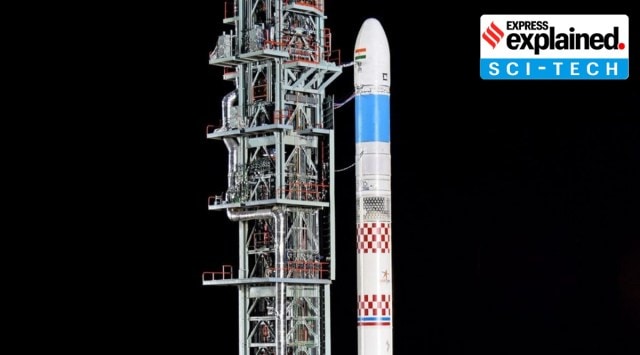- India
- International
Explained: First flight of India’s newest rocket, what it means for ISRO
On Sunday, the rocket finally embarked on its first flight, carrying two satellites, including an earth observation micro-satellite called EOS-02. And though it is not exactly clear what happened, the flight did not go along expected lines.
 Originally scheduled for 2018, the launch of the SSLV was pushed back several times. The pandemic played its part, but there have been delays from the side of ISRO (Indian Space Research Organisation) as well. (Facebook/ISRO)
Originally scheduled for 2018, the launch of the SSLV was pushed back several times. The pandemic played its part, but there have been delays from the side of ISRO (Indian Space Research Organisation) as well. (Facebook/ISRO)It was one of the most keenly-awaited launches of recent years. The maiden flight of the SSLV or the Small Satellite Launch Vehicle, India’s newest addition to its rocket fleet, had been postponed several times in the last three years. The pandemic played its role, but there were delays from ISRO’s side as well.
On Sunday, the rocket finally embarked on its first flight, carrying two satellites, including an earth observation micro-satellite called EOS-02. After a successful lift-off and separation of its three stages, the flight deviated from its script. ISRO initially said there was data loss in the final stages of the flight. Later in the afternoon, the space agency elaborated saying that the rocket placed “the satellites into 356 km x 76 km elliptical orbit instead of 356 km circular orbit”, adding that the “satellites are longer be usable”.
This less-than-perfect flight of the SSLV puts a cloud of doubt over the new rocket that is being billed to become ISRO’s main launch vehicle in the coming years.
It is a rocket that can be assembled within 72 hours by a team of just 5-6 people. A rocket that costs at least one-tenth of the those currently in use. A rocket that can enable a space launch from India every week. And, a rocket that caters specifically to the small and micro satellites that constitute over 90 per cent of all satellites being launched these days.
There is a reason why it is considered a gamechanger, and is seen as something that can truly transform the Indian space sector. But Sunday’s flight has the potential to delay the timelines further.

Era of small satellites
For a very long time, small satellites — anything weighing between 5 and 1,000 kg — have had to remain content with hitching a ride to space on rockets commissioned to carry some other, larger satellites.
The timeline of the launch used to be dictated by this larger, primary, satellite, whose interests would take precedence. But with more and more businesses, government agencies, even universities and laboratories beginning to send satellites — nearly all of them falling in this category of small satellites — to space, the constraints of a piggyback ride have started to hurt.
In fact, the demand for the launch of small satellites has increased at a rapid pace in the last eight to ten years, thanks to the ever-growing need for space-based data, communication, surveillance, and commerce. Estimates suggest that tens of thousands of small satellites would be launched in the next ten years.
Satellite builders and operators, therefore, do not have the luxury to wait for months to get a berth on a rocket, or pay the very high travel costs. Increasingly, organisations are creating a constellation of satellites in space. Projects like Starlink of SpaceX or OneWeb are putting together a constellation of hundreds of satellites.
As a result, the demand for dedicated rockets that can be launched frequently, and can offer cheap rides to space, is growing. This is also a lucrative business opportunity for agencies with launching capability like ISRO, because most of the demand comes from companies that are launching satellites for commercial purposes.
Several new players, both in the government as well as private sector, have begun to offer launching services. In India, where the space sector is fast being opened up for the private sector, at least three private companies are developing rockets that can launch small satellites into space. It is to cater to this demand, and to grab this business opportunity, that ISRO has also developed the SSLV.
More launches
In a good year, ISRO makes 5-6 launches with its PSLV and GSLV (Geospatial Satellite Launch Vehicles) rockets. These rockets typically take 70-80 days to assemble.
Dozens of people work on the assembly, and each of these cost tens of millions of dollars. Though many of these also carry commercial satellites, the revenue generated is not commensurate with the costs incurred.
The SSLV is meant to change all this. This rocket is supposed to have a quick turnaround time, usually less than three days. It can be assembled on demand at short notice, and at a fraction of the cost of the existing launch vehicles. The SSLV would have the capability to carry satellites weighing up to 500 kg to the lower earth orbits (up to altitudes of 1,000 km from earth’s surface) which is one of the most sought after places in space for positioning of satellites.
But more importantly, it is likely to drastically increase ISRO’s launch rate. ISRO officials have said they are looking at 50 to 60 launches every year with the SSLV. That would practically be one launch every week, a sharp contrast from the 2-3 launches every year that ISRO has been able to manage.
More Explained
Must Read
EXPRESS OPINION
Apr 20: Latest News
- 01
- 02
- 03
- 04
- 05









































